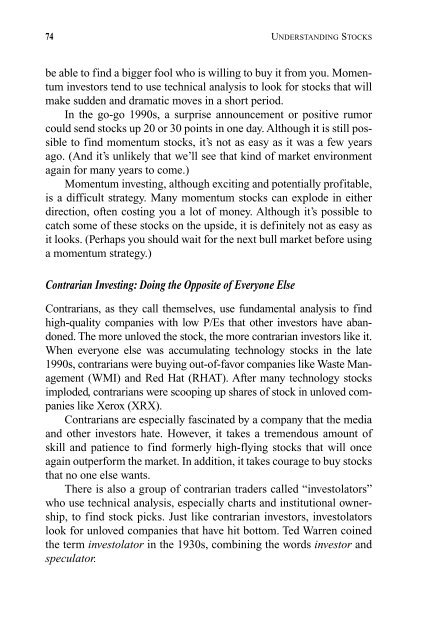Understanding Stocks
Understanding Stocks
Understanding Stocks
You also want an ePaper? Increase the reach of your titles
YUMPU automatically turns print PDFs into web optimized ePapers that Google loves.
74 UNDERSTANDING STOCKS<br />
be able to find a bigger fool who is willing to buy it from you. Momentum<br />
investors tend to use technical analysis to look for stocks that will<br />
make sudden and dramatic moves in a short period.<br />
In the go-go 1990s, a surprise announcement or positive rumor<br />
could send stocks up 20 or 30 points in one day. Although it is still possible<br />
to find momentum stocks, it’s not as easy as it was a few years<br />
ago. (And it’s unlikely that we’ll see that kind of market environment<br />
again for many years to come.)<br />
Momentum investing, although exciting and potentially profitable,<br />
is a difficult strategy. Many momentum stocks can explode in either<br />
direction, often costing you a lot of money. Although it’s possible to<br />
catch some of these stocks on the upside, it is definitely not as easy as<br />
it looks. (Perhaps you should wait for the next bull market before using<br />
a momentum strategy.)<br />
Contrarian Investing: Doing the Opposite of Everyone Else<br />
Contrarians, as they call themselves, use fundamental analysis to find<br />
high-quality companies with low P/Es that other investors have abandoned.<br />
The more unloved the stock, the more contrarian investors like it.<br />
When everyone else was accumulating technology stocks in the late<br />
1990s, contrarians were buying out-of-favor companies like Waste Management<br />
(WMI) and Red Hat (RHAT). After many technology stocks<br />
imploded, contrarians were scooping up shares of stock in unloved companies<br />
like Xerox (XRX).<br />
Contrarians are especially fascinated by a company that the media<br />
and other investors hate. However, it takes a tremendous amount of<br />
skill and patience to find formerly high-flying stocks that will once<br />
again outperform the market. In addition, it takes courage to buy stocks<br />
that no one else wants.<br />
There is also a group of contrarian traders called “investolators”<br />
who use technical analysis, especially charts and institutional ownership,<br />
to find stock picks. Just like contrarian investors, investolators<br />
look for unloved companies that have hit bottom. Ted Warren coined<br />
the term investolator in the 1930s, combining the words investor and<br />
speculator.

















